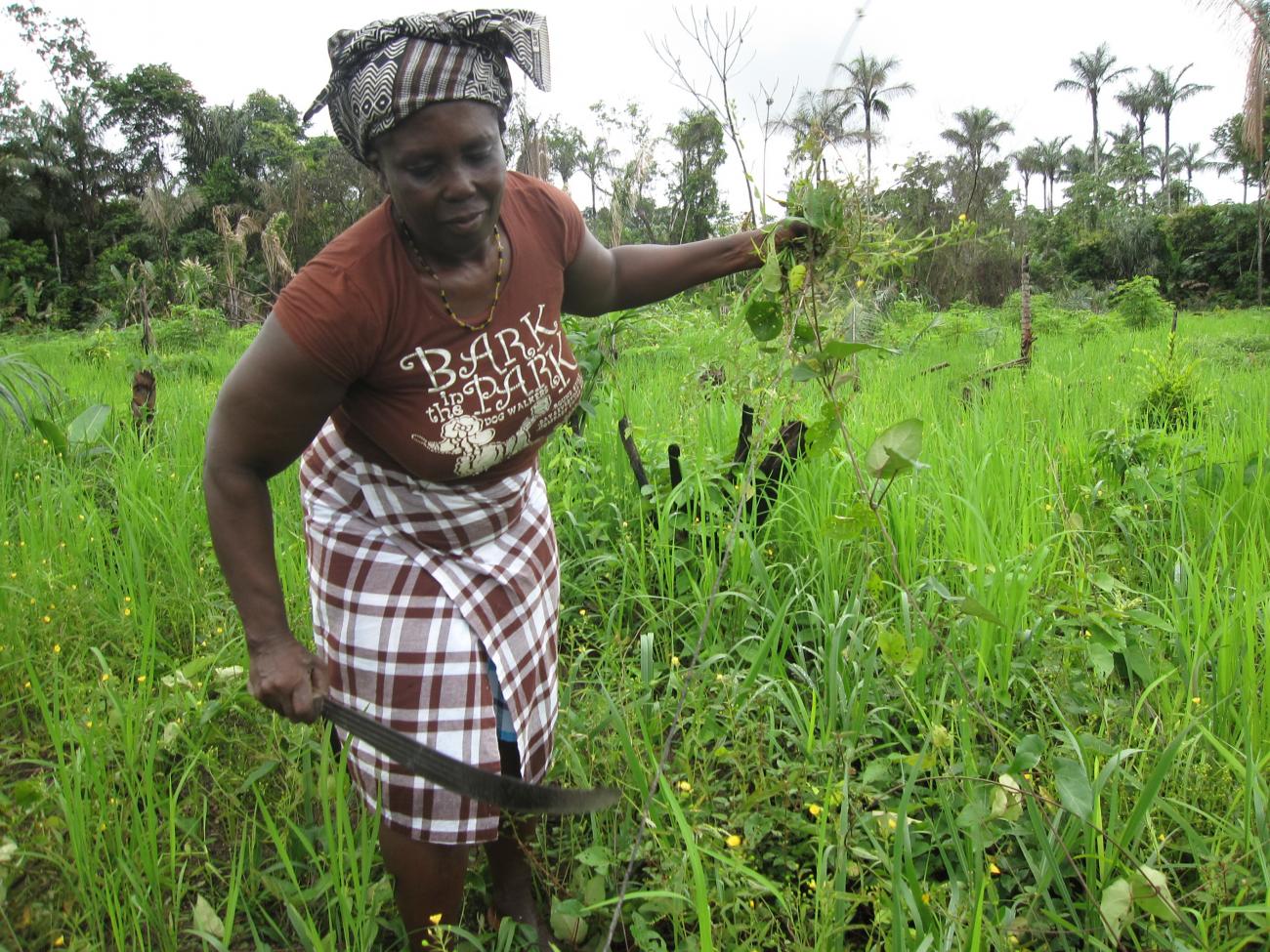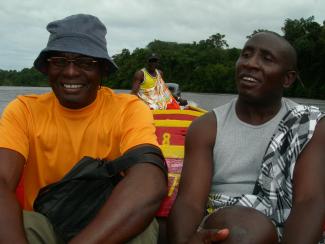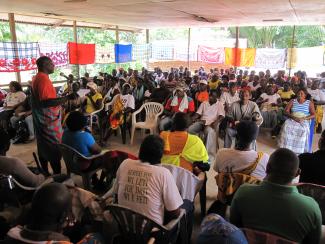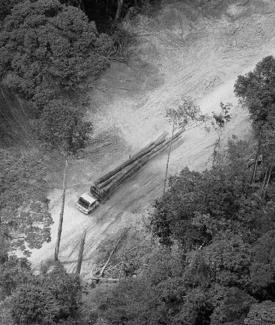
By Richard Price
Suriname, in northeastern South America, has the highest proportion of rainforest within its national territory, and the most forest per person, of any country in the world. In 2007, after a decade of legal struggle, the Saamaka People - some 55,000 descendants of self-liberated African slaves – won a signal victory before the Inter-American Court of Human Rights. Their rebel ancestors fought for nearly a century and finally signed a peace treaty with the Dutch colonizers that granted them their freedom and territory in 1762. By then they had already developed a vibrant and independent culture – their own language, religion, kinship and legal system, and much else. (Beginning in mid-2010, the people formerly known as “Saramaka” began calling themselves, in their official documents, “Saamaka,” to conform to their own pronunciation.)
Then, during the 1990s, Saamakas suddenly found their territory invaded by Chinese and other multinational logging and mining companies which were extracting resources with the explicit permission of the State. The new constitution of Suriname (an independent republic since 1975) specifies that all non-titled land and resources belong to the State, rendering Maroon Peoples such as the Saamaka (and five similar groups) as well as Suriname’s numerous Indigenous Peoples, little more than guests on government lands. The constitution also denies the possibility that an Indigenous or Maroon People could have a juridical personality and therefore collective rights to property (or to anything else). After Chinese loggers began to devastate their territory, Saamakas managed to organize their more than sixty villages strung out along the Suriname River for the coming legal battle. Silvi Adjako (pictured here), whose gardens were destroyed by the Chinese loggers, later said, “If you saw what they did, it would make you cry!” In 2000, they petitioned the Inter-American Commission for Human Rights, eventually leading to their 2007 victory before the Court.
For their leadership in this struggle, Saamaka Headcaptain Wazen Eduards and Saamaka law student Hugo Jabini were awarded the Goldman Environmental Prize (often referred to as the environmental Nobel Prize), under the banner of “A New Precedent for Indigenous and Tribal Peoples.” They were cited for:
having guaranteed territorial rights not just for the Saramaka, but for all of the Maroons and indigenous people.... In addition, because the case was settled by the binding Inter-American Court, Eduards and Jabini changed international jurisprudence so that free, prior and informed consent will be required for major development projects throughout the Americas. They saved not only their communities’ 9,000 square-kilometers of forest, but strengthened the possibility of saving countless more.
During the Saamakas’ legal struggle and at the decisive hearing before the Court in Costa Rica, I served as advisor and expert witness on behalf of the Saamaka People, having carried out ethnographic work with them since 1966. My book, Rainforest Warriors: Human Rights on Trial (University of Pennsylvania Press, 2011, winner of the 2012 Best Book Prize for Human Rights of the American Political Science Association), describes the Saamakas’ historical and spiritual relationship to their territory, its recent desecration in the name of national development by the State, and the events of the trial itself. In this article, I focus on the subsequent story, which raises questions about the on-the-ground effects of landmark human rights legislation, especially in situations of continuing power inequality. Nearly five years after the Judgment, the story of their cultural survival remains open-ended.
In their landmark decision of 2007, Saramaka v Suriname, after reviewing a great deal of specific testimony (much of it anthropological), the justices concluded that:
the members of the Saramaka people make up a tribal community ... not indigenous to the region, but that share similar characteristics with indigenous peoples ... whose social, cultural and economic characteristics are different from other sections of the national community, particularly because of their special relationship with their ancestral territories, and because they regulate themselves, at least partially, by their own norms, customs, and/or traditions.
The justices wrote that, like Indigenous Peoples, the Saamaka are therefore “subject to special measures that ensure the full exercise of their rights.” Henceforth, Saamakas, and other Maroons throughout the Americas, would be treated as equivalent to Indigenous Peoples in international law and subject to the United Nations Declaration on the Rights of Indigenous Peoples.
The Judgment also concluded that the State had violated Articles 3 (Right to Juridical Personality), 21 (Right to Property), and 25 (Right to Judicial Protection), in relation to Article 1(1) (Obligation to Respect Rights) of the American Convention on Human Rights, and ordered the State of Suriname to take a series of ten actions, the most important of which were that:
The State shall delimit, demarcate, and grant collective title over the territory of the members of the Saramaka people, in accordance with their customary laws, and through previous, effective and fully informed consultations with the Saramaka people.
Indeed, the justices specified that the map made by the Saamaka People and presented to the Court, which included territorial boundaries as defined by their history and traditions, would serve as the benchmark for titling by the State.
The State shall grant the members of the Saramaka people legal recognition of the collective juridical capacity, pertaining to the community to which they belong, with the purpose of ensuring the full exercise and enjoyment of their right to communal property, as well as collective access to justice, in accordance with their communal system, customary laws, and traditions.
The State shall remove or amend the legal provisions that impede protection of the right to property of the members of the Saramaka people and adopt, in its domestic legislation, and through prior, effective and fully informed consultations with the Saramaka people, legislative, administrative, and other measures as may be required to recognize, protect, guarantee and give legal effect to the right of the members of the Saramaka people to hold collective title of the territory they have traditionally used and occupied as well as their right to manage, distribute, and effectively control such territory, in accordance with their customary laws and traditional collective land tenure system.
The State shall adopt legislative, administrative and other measures necessary to recognize and ensure the right of the Saramaka people to be effectively consulted, in accordance with their traditions and customs, or when necessary, the right to give or withhold their free, informed and prior consent, with regards to development or investment projects that may affect their territory, and to reasonably share the benefits of such projects with the members of the Saramaka people, should these be ultimately carried out.
The State shall allocate the amounts set in this Judgment as compensation for material and non-material damages in a community development fund created and established for the benefit of the members of the Saramaka people [a total of $675,000 US].
In other words, the Judgment requires Suriname to change its laws (and, if necessary, its constitution) in order to grant the Saamaka People collective title to their traditional territory as well as considerable sovereignty over it – jurisprudence that henceforth applies to all Indigenous Peoples and Maroons in the Americas. As Saamaka Headcaptain Wazen (pictured here) put it, “As captain, I was delighted by the verdict. What’s rightfully ours has finally been given back to us. That’s why the Saamakas, my people, all of us, stood together until we won this fight.”
The five years since the judgment bear witness to the multiple challenges faced by both plaintiffs and defendants in complex cases of human rights violations, where national development (such as mining, logging, and other extractive industries) is pitted against the rights of Indigenous or Maroon populations. National development – what the State calls “modernization” – has continued to drive Suriname’s policies, with scarcely a backward glance at the strictures imposed by the Court. In its various pronouncements and communications, the State has taken the position that it can resolve the Saamaka situation only as part of a broader reconsideration of the place of all Indigenous Peoples and Maroons within Suriname, unilaterally (and illegally) postponing compliance with the Court’s Judgment. Meanwhile, the Saamaka People have continued to barrage the government and the Court with reports and petitions documenting the State’s lack of action in fulfilling the terms of the Judgment.
In July 2010, Desi Bouterse – ex-dictator, convicted drug dealer, and accused murderer of fifteen political opponents in 1982 – was chosen by parliament to be president of Suriname, after his NDP party won a majority in the May elections. To date, his administration has not strayed from the policies of his predecessor regarding Maroons and Indigenous Peoples. Indeed, it has relied on much the same personnel and organizations that have been involved for years in such matters.
Among the headlines involving Saamakas, other Maroon Peoples, and Indigenous Peoples since Bouterse’s inauguration, I would mention:
—In December 2010, President Bouterse announced that his administration had signed a 6 billion US dollar memorandum of understanding with China to finance (among other mega-projects) a railroad and highway from Paramaribo to Manaus (Brazil), cutting right through the heart of Saamaka territory. There was no mention of the Saramaka People Judgment nor any consultation with Saamaka representatives.
—In January 2011, Canadian multinational Iamgold announced that it would increase substantially its investments in Suriname, with the intent of expanding its Rosebel Mine (which lies in traditional Saamaka territory) at the same time as announcing record fourth-quarter profits from the mine. In a separate communiqué, the company announced that it would need considerable additional cheap energy to meet its production targets and therefore planned to invest heavily in the proposed Tapajai project, which would dam the Tapanahoni river in Ndyuka Maroon territory (sinking numerous villages), bring its waters through vast canals along the Jai Creek into Saamaka territory, have them flow into the Afobaka reservoir, where rising water levels would sink several Saamaka villages, all to increase hydropower at the Afobaka dam. Meanwhile, the Suriname government has contracted with CNEC, a Brazilian engineering consultancy, to make a feasibility study for what is now expected to be a 1-billion US$-plus project. There has been no consultation with Saamaka (or Ndyuka) representatives.
—In February 2011, after seven months of protests and meetings by Pamaka Maroons against government plans to mine bauxite and gold in the Nassau Mountain region that they consider part of their traditional territory, followed by a public meeting at which President Bouterse spoke of the necessity of “development,” Newmont Mining announced that it had found greater gold deposits than expected and intended to begin operations in conjunction with Alcoa as soon as negotiations with the government were concluded. Despite the unanimous declaration of Maroon and Indigenous leaders that the question of land rights titles must be settled before they could react to government proposals concerning Newmont, the government is hurrying along its negotiations with the giant multinational company. In September 2011, Newmont announced that it had found twice as much gold in the region as suspected and that it would build two mines near one another at a cost of about 1 billion US$.
On December 21, 2011, the secretary of the Inter-American Court served notice to the Saamaka People, the Inter-American Commission of Human Rights, and the State of Suriname, of the Order issued by the Court on 23 November in the case of Saramaka People v Suriname. This 18-page document orders the State to submit by March 30, 2012, “a detailed report on the measures it is undertaking to comply with the reparations that remain pending.” (Among the various measures ordered by the Court that the State has not yet complied with, the Court mentions the delimitation, demarcation, and granting of collective title over the territory of the Saamaka people; the granting to the Saamaka people legal recognition as having a collective juridical capacity [a legal personality]; removing or amending the legal provisions that impede protection of the Saamakas' collective property; adopting legislative, administrative, and other measures to ensure the right of the Saamaka people to be effectively consulted, and to give or withhold their free, informed, and prior consent with regard to development projects that may affect their territory.) Thereafter, the Order continues, the State must submit a progress report on its compliance every three months. In addition, the Court will convene a private hearing (with the Saamaka People, the Commission, and the State) at a date to be determined in 2012 to consider further action. As of summer 2012, none of these orders have been carried out.
The future of Maroons and Indigenous Peoples in Suriname hovers precariously between hope and despair. The country’s economy is booming, led by gold and bauxite mining, new discoveries in offshore oil, and the unquantified but highly lucrative drug trade (and its closely linked money-laundering casino operations). The UN Economic Commission for Latin America and the Caribbean now projects that Suriname will lead all Caribbean nations with a growth rate of 4.5% in 2012. There are no signs that the national government has any plans for its Maroon and Indigenous Peoples other than their assimilation (the sooner the better) into the urban underclass, leaving the country’s forested interior free for extractive industries. In this scenario, Saamakas would be replaced in their traditional territory by Chinese loggers, Brazilian goldminers, and in select locations by wealthy city-dwellers in weekend vacation homes.
On the other hand, the Saamaka People and their Maroon and Indigenous neighbors do have the Inter-American Court and potentially the General Assembly of the Organization of American States (and the Inter-American Development Bank) on their side. Will they have the patience, and the leadership, to continue to fight what sometimes seems like an interminable and unequal bureaucratic and legal battle? To succeed, the Saamaka People will need to draw on their proud heritage of three hundred years of collective struggle for self-determination.
--Richard Price is Duane A. and Virginia S. Dittman Professor Emeritus of American Studies, Anthropology, and History at the College of William & Mary.



